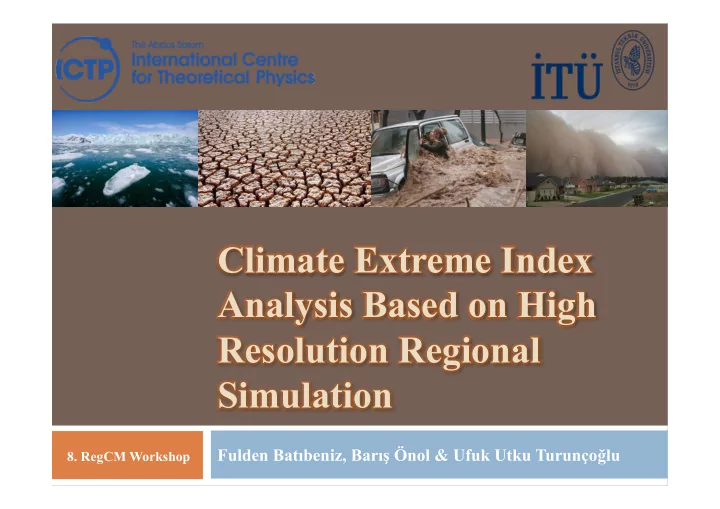

Climate Extreme Index Analysis Based on High Resolution Regional Simulation Fulden Batıbeniz, Barı ş Önol & Ufuk Utku Turunço ğ lu 8. RegCM Workshop
Contents ¡ ¨ Mo)va)on ¡ ¨ Data ¡and ¡Method ¡ ¨ Snapshot ¡of ¡Climate ¡Extreme ¡Index ¡ ¨ Analyses ¡ ¨ Findings ¡and ¡Arguments ¡
Motivation ¨ Extreme weather events are more frequent and severe in recent decades, depending on changing climate. In addition to long-term climate conditions, extreme values and extreme weather events should be known to reach more comprehensive information about the assessment of climate change.
Data ¡ ¤ Regional Climate Simulation Results (1961-2008) n Önol, B. , 2012, Understanding the Coastal Effects on Climate by Using High- Resolution Regional Climate Simulation., Climate Research , 52, 159-174. ¤ Available Water Holding Capacity Data (1961-2008) n Webb, R. W., C. E. Rosenzweig, and E. R. Levine. 2000. Global Soil Texture and Derived Water-Holding Capacities (Webb et al.). Data set. Available on- line [http://www.daac.ornl.gov] from Oak Ridge National Laboratory Distributed Active Archive Center, Oak Ridge, Tennessee, U.S.A. doi:10.3334/ORNLDAAC/548.
Experimental Design NCEP/NCAR ¡Reanalysis ¡ • Reanalysis have been Double- downscaled nested • to 10 km 50-km horizontal method resolution Forcing Data 10-km • NCEP/NCAR Reanalysis Data ICTP- • 1961-2008 RegCM3 period Model Domain & Topography 50-10km (Önol B.,2012) • Daily max and min temperatures • Daily Precipitation
Experimental Black Sea Design • Resolving Complex topography • Resolving Land-sea distribution Med. Sea Fine resolution climate information needed for adaptation studies Extreme Events? 3-D Representation of Model Domain
Method ¨ The Climate Extremes Index (CEI) has been calculated by using multivariate and multidimensional indicators for United States and originally developed by Karl et al. (1996) to represent impact of climate change more evident. ¨ The CEI is driven by five indicators, which are extreme maximum and minimum monthly mean temperature, extreme total precipitation, precipitation/non-precipitation days, and the Palmer Drought Severity Index (PDSI) based on the annual or seasonal periods. ¨ Extremes for each indicator are calculated in terms of occurrences of above/below based on the 90th/10th percentile value over the whole period.
Method ¨ Five indicators composing annual CEI are; ¨ extreme maximum and minimum daily temperature, ¨ extreme total precipitation, ¨ precipitation/non-precipitation days, and ¨ the Palmer Drought Severity Index (PDSI) in terms of severe drought and severe moisture surplus. ¨ 1961-2008 period used as reference period in order to define 90th/10th percentile and occurrence of extremes on the annual basis.
Method ¨ According to the definition, CEI calculated by using daily precipitation data, monthly PSDI data, monthly maximum and minimum temperature data. However, in this study CEI has been calculated and annual analyses have been carried out by using revised CEI formulation (shown on the below). Daily temperature values have been used instead of monthly data. Additionally, calculations have been performed on the basis of model grid.
Snapshot of CEI: The Year of 1997 First of all 10th/90th percentile values for each indicator have ¨ been determined by using whole period. Subsequently, percentages which above/below percentiles have been calculated. Sum of percentages, which is determined for each indicator, ¨ represents the same expected average extreme value (%20) . The five indicator values for each year are given equal weight and are averaged together. The resulting CEI averages show the percent area that is ¨ considered extreme based on the combined effects of the five indicators.
���������������������������� ���������� ������������������������������������� ���������������������������� ���������� �������������������������������������� ������������������������������������� �������������������������������������� Results Decadal anomaly of ¨ CEI (reference period 1961-1990) has been investigated for the simulation period. CEI demonstrates ¨ decreasing signal until the end of 1979 (1-4%) It starts to increase ¨ from 1980s. The extreme events ¨ e n h a n c e f o r t h e periods of 1990-1999 and 2000-2008. Especially, Aegean ¨ Region and West part of Turkey experiences increased CEI in range of 1-6%. ������������������������������� ������������������������������� � � � � � � � � �������� � � � � ��������
Decadal Trend ¨ The annual mean of CEI represents that Turkey and its surroundings area are experienced extreme events in the range of 18-34%. ¨ Decadal trend of CEI indicates positive signal in range of 1-2%.
Inter-annual Variability
Conclusion In terms of CEI calculation, Turkey and its surrounding area are experienced extreme events ¨ in the range of 18-34%. In addition, the decadal anomalies of CEI demonstrates decreasing signal until the end of ¨ 1979 (1-3%) and it starts to increase from 1980s. CEI indicates positive signal in range of 1-6% for last 30 year period. The trend analysis of CEI reveals decadal positive increase up to 1-2% (per decade) over ¨ Turkey. Especially, northern Balkans, Aegean region of Turkey, Mediterranean region, some part of ¨ the Central Anatolia region and Northwest of Arabian peninsula have experienced highest increasing signal in range of 3-6%. The changes of the extremes over these regions are also considered as hotspot due to their dense population. Interannual analyses indicates that CEI has increasing signal over Balkans, Aegean region ¨ (Turkey) and Syria. Additionally, two consecutive years (1990 and 1991) are the most prominent period for regional interannual variability of CEI.
THANK YOU..
Recommend
More recommend